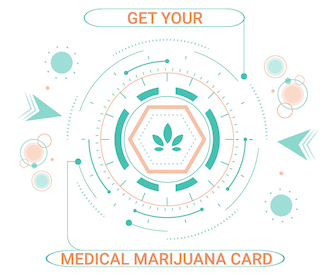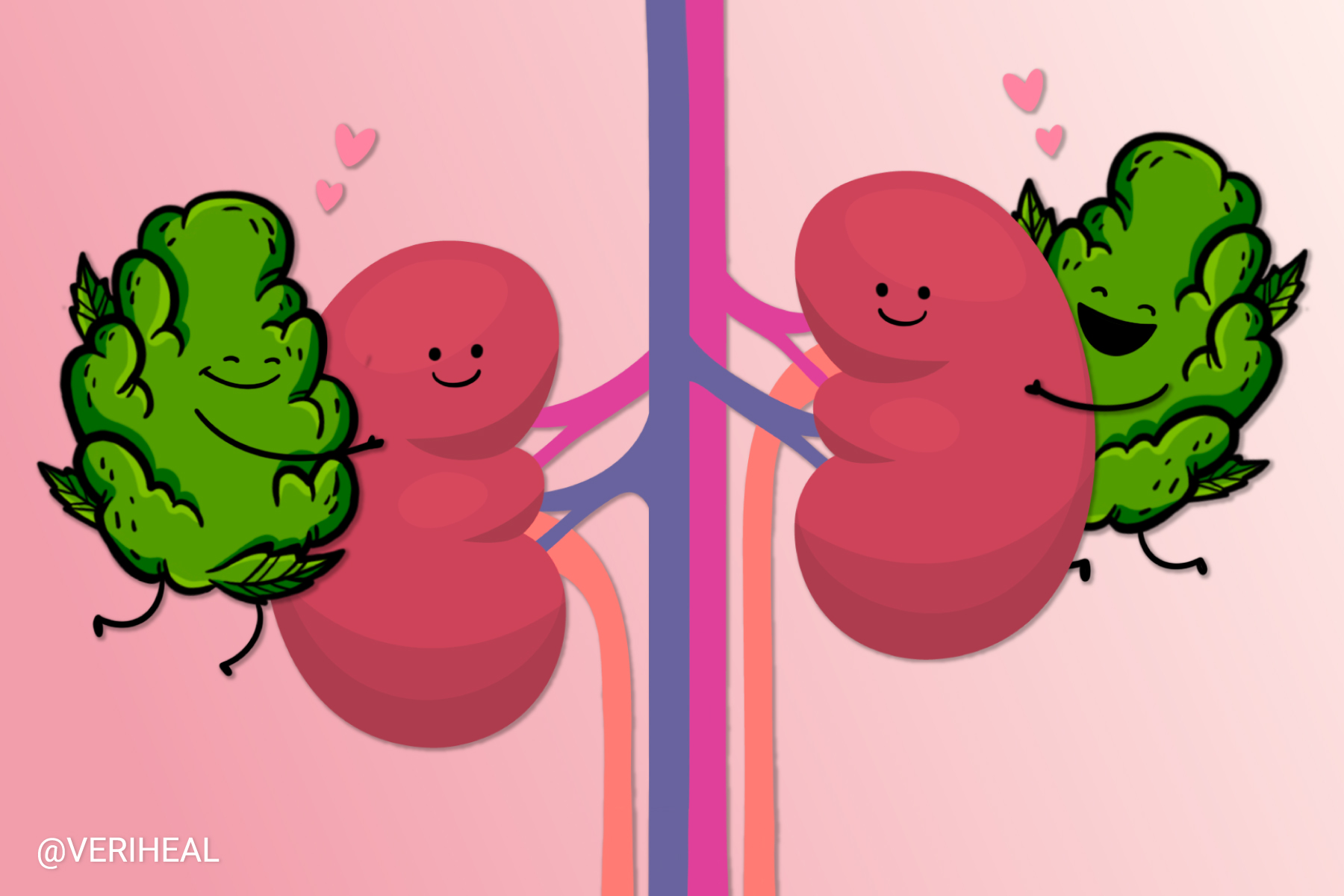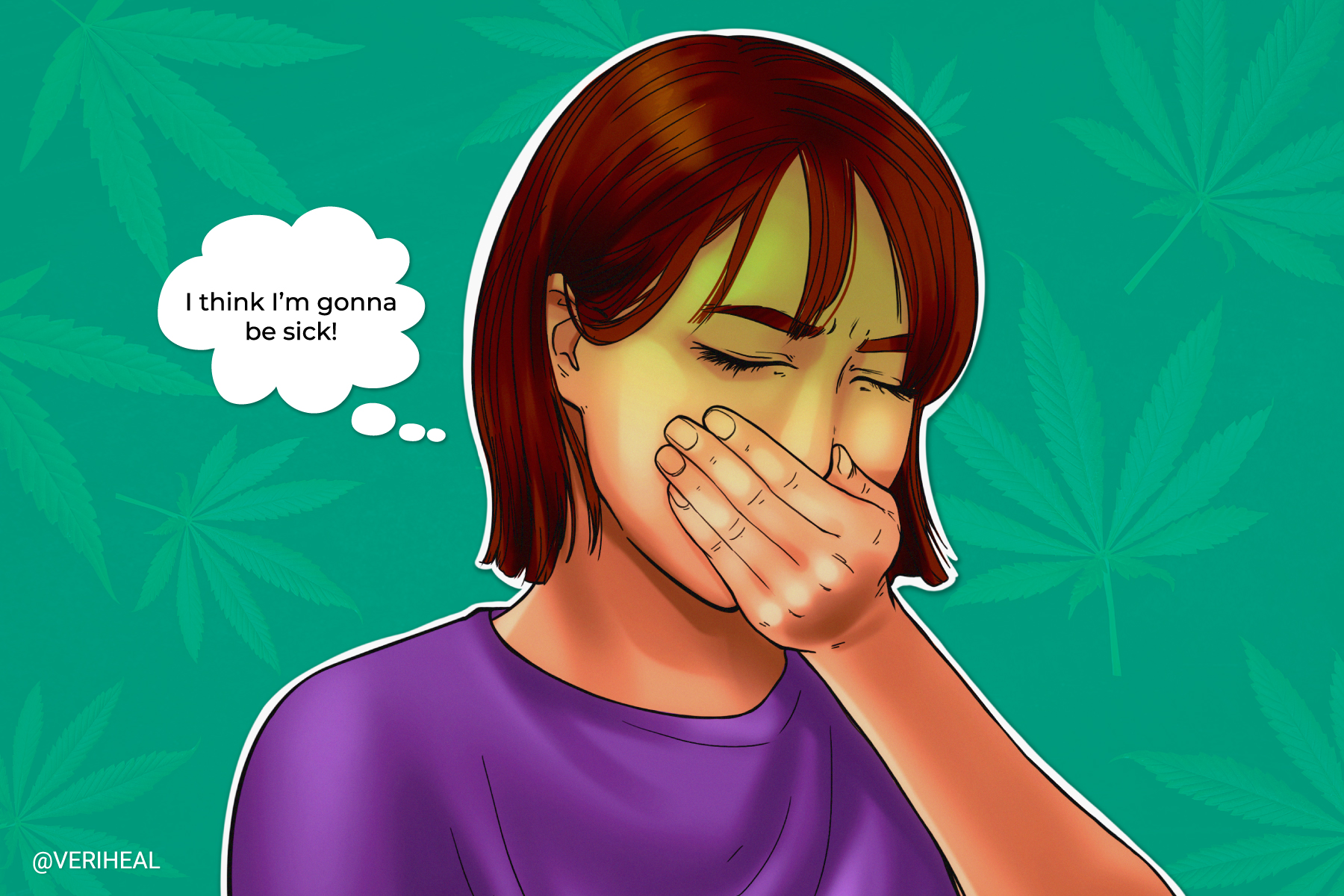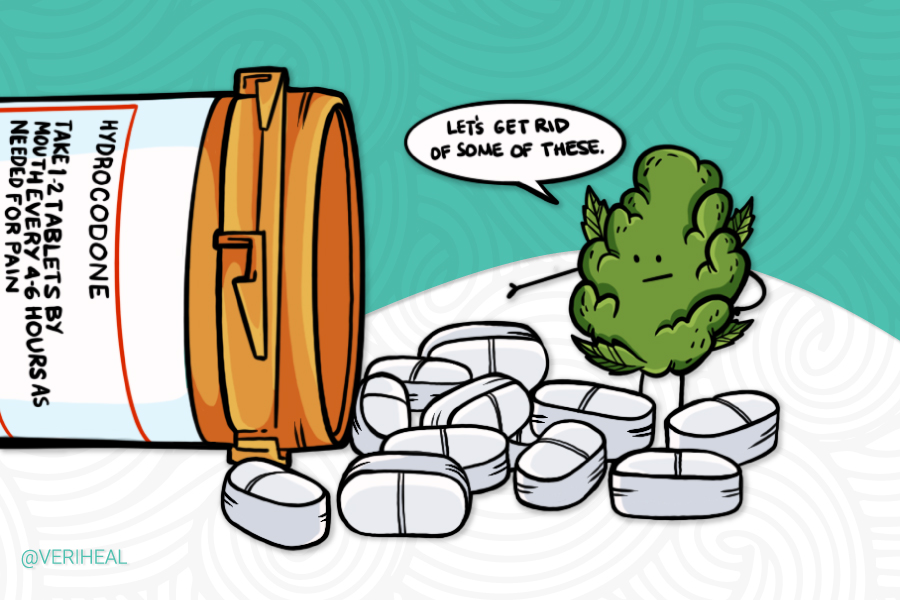Medical Cannabis May Help with Side Effects of Chronic Kidney Disease and Dialysis
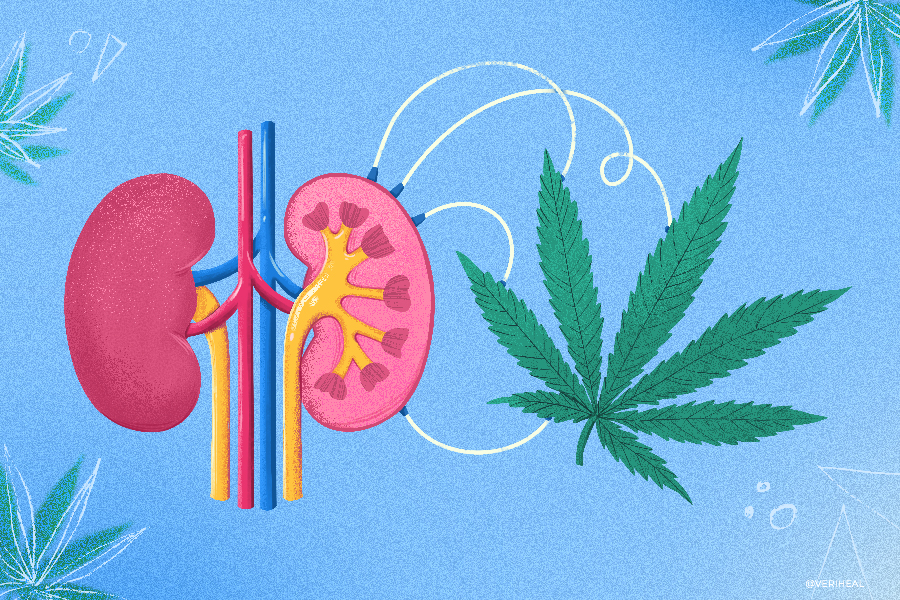
Table of Contents
- The ECS and the Kidneys
- What Symptoms and Side Effects of of Dialysis/ CKD Can Cannabinoids Help With?
- CKD Risk Factors and Side Effects
- Chronic Kidney Disease Treatment
Chronic kidney disease (CKD) causes kidneys to be damaged and unable to filter blood the way healthy kidneys do. The disease is considered “chronic” because the damage to kidneys happens gradually and kidney health declines over an extended period of time (35). This damage can cause toxic waste, medications, and excess fluid to accumulate in the body. CKD may also cause other health problems including, but not limited to— high blood pressure, stroke, and heart disease. There are options to treat symptoms of CKD that an individual can explore with a healthcare professional (8).
Medical cannabis has proved to alleviate symptoms in dozens of underlying conditions due to its positive effects on the endocannabinoid system (ECS), a multiplex cell-signaling process. Some common conditions medical cannabis has proven to help include chronic pain, nausea and vomiting, itching, decreased appetite, insomnia, and inflammation, all of which are symptoms and risks of CKD and dialysis, reports Healthline (15, 11).
The prevalence of CKD and related health problems in America qualifies it as a significant public health issue. As more states continue to pursue the legalization of recreational and medical cannabis, patients have greater access to high-quality products that may help alleviate symptoms of CKD and dialysis.
The ECS and the Kidneys
The ECS is made up of fat-based neurotransmitters, which are influenced by cannabinoids found in the cannabis plant—such as Δ9-tetrahydrocannabinol (THC) and cannabidiol (CBD)— when they come into contact with the two different types of cannabinoid receptors (CB1 and CB2)(4).These receptors are found in numerous tissues throughout the body, including the kidneys (28).
The ECS helps the body with several processes including maintaining proper body temperature, pain perception and controlling inflammation in our body. When these receptors are activated, they increase or decrease our natural endocannabinoid levels.
Endocannabinoids, such as anandamide (AEA) and 2-arachidonoylglycerol (2-AG), are fat-based neurotransmitters that are responsible for a variety of processes in our bodies (32). These processes include regulating sleep and pain perception, as well as modulating our immune system to slow down inflammation.
The role of the ECS in renal pathology—which deals with the diagnosis and characterization of medical diseases of the kidneys— is an emerging area of research. It has been studied primarily in the context of CB receptors. Under normal conditions, CB1 receptors are involved in regulating kidney blood flow, salt and water clearance and absorption, and urinary protein excretion.
Modifications of CB receptor expression and activity have been found in various renal diseases including but not limited to CKD and different types of kidney injury, such as diabetic nephropathy and acute kidney injury (AKI). The current research suggests that targeting the ECS may be of diagnostic and therapeutic value (9).
According to a review of recent findings related to CB receptors in the kidneys, “Studies using isolated cells, rodent models, and human studies have identified a critical role for the endocannabinoid system in renal function and disease. Thus, therapeutics that modulate the activity of CB2 and CB1 receptors in renal disease could become clinically relevant” (12).
Some experimental studies suggest that cannabinoids such as d-9-THC and endocannabinoids such as AEA can activate these CB receptors, and have either beneficial or harmful effects on kidney function, dependent on a variety of factors.
Currently, there is a lack of human studies exploring both the impact of cannabis use on healthy kidneys and on kidney function in patients with kidney disease. Further research is needed in this area and will limit the adverse effects of these substances while advancing their potential beneficial impacts on renal function in various types of kidney diseases (28).
What Symptoms and Side Effects of Dialysis / CKD Can Cannabinoids Help With?
There are several side effects of CKD and dialysis that medical cannabis has been linked to helping alleviate. Although in many cases further research is needed, there are several conditions that already have substantial research to back up claims that medical marijuana may be a viable and effective treatment for side effects such as nausea and vomiting, decreased appetite, itching, inflammation, and chronic pain management (11).
Medical Cannabis and Chronic Pain Management
The prevalence of pain as a symptom among patients with CKD is as high as 50% (14). To manage this pervasive symptom, over 60% of dialysis patients receive at least one opioid prescription every year and an estimated 20% of them take prescription opioids chronically.
Both the short-term and chronic use of prescription opioids has been associated with increased morbidity and mortality. This combined with the toxicity and dependence potential of opiates presents a clear need for alternative methods to manage pain as a way to reduce these secondary impacts of treating symptoms of CKD and dialysis (39). Access to medical cannabis has been connected with a decrease in opioid prescriptions as well as dose reductions (30).
The National Academies concluded that “substantial evidence” exists for the use of cannabis and cannabinoids to treat chronic pain (25). Findings suggest that medical cannabis users managing chronic pain with cannabis—as an adjunct of or in place of opioids—may “reduce the personal and social harms associated with addiction, particularly in relation to the growing problematic use of pharmaceutical opiates (18).”
Chronic, neuropathic pain patients without renal disease have reported a minimum 30% decrease in their pain by using cannabis. This could potentially be extrapolated to people with renal disease. Although cannabis could have a therapeutic role in chronic pain management, further clinical trial investigation is needed particularly in this set of patients.
Medical Cannabis and Itching (Pruritus)
The ECS plays an important role in maintaining skin homeostasis and also has broader impacts on neurogenic responses such as itching, inflammation, and immune reactions. Although CB1 and CB2 are recognized as the main cannabinoid receptors, there is noteworthy overlap between cannabinoids and ligands of TRP receptors as well.
Transient receptor potential (TRP) channels are membrane proteins. These channels regulate ion entry, moderating several neural signaling processes involved with pain perception, the sensation of temperature, pressure, among others. Many diseases involve TRP channel dysfunction, including neuropathic pain, inflammation, and respiratory disorders (23).
Researchers have found that, “The evidence in the literature suggests the anti-pruritic effects of cannabinoids are due to a combination of effects on neuronal activation, transmission along the afferent pathway, and local modulation of keratinocyte and mast cells. The anti-pruritic effect of cannabinoid receptor ligation on peripheral and central nervous tissue may be a result of actions at multiple receptors, as experiments in various models of skin diseases show individual CB1, CB2, or TRP channel modulation exhibit reduced pruritus (6).”
Medical Cannabis and Inflammation
Cannabinoids are potent anti-inflammatory agents, even more potent than Vitamin C or E. In CKD and other kidney diseases, inflammation occurs within kidney tissue and other organs. Pericarditis, a prevalent symptom of CKD and dialysis, causes abnormal inflammation, one of the most popular conditions treated with medical cannabis. One of the most popular reports demonstrating that CBD is good for inflammation was published in a 2009 edition of Future Medicinal Chemistry.
“Cannabinoid receptors include CB1, which is predominantly expressed in the brain, and CB2, which is primarily found on the cells of the immune system,” according to the study. “The fact that both CB1 and CB2 receptors have been found on immune cells suggests that cannabinoids play an important role in the regulation of the immune system.” Since inflammation is the body’s response to harm and injury, it would make sense that medical cannabis helps with symptom management of CKD and dialysis (40).
Interestingly, recent studies have shown a mixed protective/deleterious role of cannabinoid receptors in the kidney in response to inflammation and tissue injury (41). Ironically, CB1 receptor activation could make kidney inflammation worse while CB2 receptor activation on immune cells reduces inflammation. It may be best to selectively use a CB1 antagonist and CB2 agonist for kidney-related inflammation according to reviewed studies. Follow up systematic reviews on CBD as an anti-inflammatory and antioxidant continue to be published with new findings such as the fact that CBD is a more potent antioxidant than Vitamin C or E (5).
Medical Cannabis and Insomnia
CKD also causes problems sleeping, making insomnia an unwelcome side effect. Again, medical cannabis proves to help the symptom through the non-psychoactive cannabidiol CBD and psychoactive THC.
In 2008, a study reported by the journal Sleep Medicine Reviews showed how “smoked marijuana and oral Delta-9-tetrahydrocannabinol (THC) reduce REM sleep. Moreover, acute administration of cannabis appears to facilitate falling asleep and to increase Stage 4 sleep (34).”
A clinical trial in 2021 exploring treating insomnia with medical cannabis found that, “two weeks of nightly sublingual administration of a cannabinoid extract (ZTL-101) is well tolerated and improves insomnia symptoms and sleep quality in individuals with chronic insomnia symptoms (43).” This trial was placebo-controlled and randomized, giving it greater evidence strength.
Echoing this, larger systematic reviews on cannabis and sleep have shown therapeutic potential for cannabinoids like THC, CBD, and nabilone for insomnia, daytime sleepiness, PTSD nightmares, and REM sleep behavior disorder. However, some studies note that THC in the long term may impair sleep quality.
Medical Cannabis and Nausea and Vomiting
There is substantial evidence that manipulation of the ECS regulates nausea and vomiting in humans and animals. Both preclinical and human research indicates that cannabinioids, including CBD, may be effective clinically for treating both nausea and vomiting (44).
Some studies that have investigated cannabinoids such as THCA have found that this cannabinoid has heightened potential for treating nausea and vomiting. According to one study, THCA proved to be “a more potent alternative to THC in the treatment of nausea and vomitting (45).” More research is needed in this area to fully explore the different cannabinoids and their medical value.
Learn more about how medical cannabis could be a treatment for nausea here.
CKD Risk Factors and Side Effects
There is a five-stage breakdown of CKD— from mild to failure— that takes place before dialysis begins. Signs and symptoms of kidney disease in the early stages are often nonspecific. In essence this means that symptoms can also be attributed to other illnesses that ultimately cause kidney disease.
Due to the fact that the kidneys can compensate for lost function, an individual with CKD might not develop signs and symptoms until irreversible damage has already transpired (21). For example, high blood pressure is often called the “silent killer” in medicine because people will often not notice it. With the nonspecific nature of signs and symptoms attributed to decreased kidney function and CKD in mind, the statistic that approximately 9 out of 10 American adults with CKD are unaware that they have CKD, may come as a surprise.
The U.S. Centers for Disease Control (CDC) reported in 2021 that about 1 in 7, or 15% of the U.S. population — 37 million people — are estimated to have CKD (42). The report details that this is due to the high prevalence of risk factors to the disease, including:
- Diabetes
- Hypertension
- Obesity
- Cardiovascular disease
- Sedentary Lifestyle
- Poor Diet
Your doctor may recommend a urine protein:creatinine test or an eGFR— estimated glomerular filtration rate— test, which shows how well your kidneys are filtering blood, if you are at higher risk of developing kidney disease (10). When you have albumin (protein) in your urine, it is called “albuminuria,” and this could be a sign of early kidney disease (38). Visiting your doctor regularly and getting annual physicals is a good way to catch early signs of CKD. If you have a chronic condition like diabetes or high-blood pressure, you should see your doctor and managing specialists more regularly to control these conditions that can cause serious complications like CKD.
Chronic Kidney Disease Treatment
What are standard preventive options?
From dialysis to medication, there are treatment options available to those diagnosed with CKD. Proper diet and nutrition counseling (e.g. mediterranean diet, low salt and low sugar), along with exercise and lifestyle changes (i.e. quitting smoking and alcohol drinking), are very important for preventing and managing kidney disease.
Once a patient is diagnosed with diabetes, hypertension, or other kidney-compromising condition, and begin controlling those underlying diseases through diet, exercise, and medication—these control methods are the most important ways to prevent CKD. According to the National Kidney Foundation, “For those with CKD, hypertension control and use of an angiotensin-converting enzyme (ACE) inhibitor or angiotensin receptor blocker (ARB) are foundations of optimal care (46).”
Diabetes stands out as the most frequent cause of CKD, leading to nearly half of all cases of kidney failure requiring replacement therapy. Today many different glucose-lowering medications are accessible to patients living with diabetes and CKD, such as metformin, insulin, and sodium/glucose cotransporter 2 (SGLT2) inhibitors. SGLT2 inhibitors lower blood glucose levels by preventing glucose and sodium reabsorption in the proximal tubule (26). In the past, people that were diabetic and had CKD had a limited choice of glucose-lowering agents due to a variety of issues. In CKD, medications can build up in the system and potentially cause severe side effects. Medications are commonly “renally-adjusted” for patients with CKD.
What is Dialysis?
When kidneys fail, which is the product of end stage renal disease (ESRD), the patient will eventually need a kidney transplant. In the mean time, dialysis keeps the body in balance by removing extra water, salt, and waste from your blood to prevent them from building up in your body. Dialysis also helps to keep a safe level of chemicals in the blood such as sodium, bicarbonate, and potassium. Additionally dialysis helps regulate blood pressure.
Keep in mind that CBD can raise levels of certain medications including tacrolimus, an immunosuppresant given to transplant patients. Also, be aware in advance of the policies of your transplant center. Sadly, some transplant centers will refuse to perform transplant surgery or organ harvesting on patients and donors who test positive for cannabis use even though there is no real medical reason for doing so. They may reject candidates who use or abuse alcohol or other substances as a blanket policy.
There are two types of dialysis: hemodialysis, when an artificial kidney called a hemodialyzer removes waste and chemicals from the blood from a surgically-made fistula (artificial artery/vein junction). This then requires going to a kidney treatment center usually every other day. The second type is called peritoneal dialysis, which is performed by surgery with catheters to clean the blood from inside the body (20). This kind of dialysis can be performed at home using the catheter ports.
As a blood-filtering treatment for chronic kidney disease (CKD), dialysis keeps millions alive when their body begins to break down aggressively. The National Kidney Foundation (NKF) reports dialysis is needed for survival when the kidney function is at 15% or lower, leaving patients with sometimes harsh side effects from the treatment (27).
What are the Side Effects of CKD and Dialysis Treatment?
Dialysis is very uncomfortable, costly, and time-consuming for most patients. Additionally, some of the side effects of loss of kidney function include, but are not limited to:
- Nausea and vomitting
- Symptoms related to low blood pressure (hypotension)
- High blood pressure (hypertension)
- Anemia
- Anorexia
- Dry or itchy skin
- Symptoms related to restless leg syndrome (RLS)
- Muscle cramping
- Sleep problems
- Bone diseases
- Amyloidosis
- Inflammation of the kidney, organs, and the membrane surround the heart (pericarditis)
- Lethargy
- Anxiety
- Depression (2)
- Pain
Individuals that are living with CKD and going through dialysis treatment could experience any number of these symptoms. Although more research is needed, medical cannabis has the potential to offer relief from many of these symptoms. The research thus far suggests that both THC and CBD and their effect on the ECS will be a promising area of study for the field of nephropathy and renal pathology.
Note: Veriheal does not intend to give this as professional medical advice. Do not attempt to self-diagnose, or prescribe treatment based on the information provided on this page. Always consult a physician before making any decision on the treatment of a medical condition.
1. Abuhasira, R., Haviv, Y. S., Leiba, M., Leiba, A., Ryvo, L., & Novack, V. (2021). Cannabis is associated with blood pressure reduction in older adults – a 24-hours ambulatory blood pressure monitoring study. European Journal of Internal Medicine, 86, 79–85. https://pubmed.ncbi.nlm.nih.gov/33483174/
2. Aggarwal, H. K., Jain, D., Dabas, G., & Yadav, R. K. (2017). Prevalence of depression, anxiety and insomnia in chronic kidney disease patients and their co-relation with the demographic variables. PRILOZI, 38(2), 35–44. https://pubmed.ncbi.nlm.nih.gov/28991772/
3. Alshaarawy, O., & Elbaz, H. A. (2016). Cannabis use and blood pressure levels. Journal of Hypertension, 34(8), 1507–1512. https://www.ncbi.nlm.nih.gov/pmc/articles/PMC5237375/
4. Atakan, Z. (2012). Cannabis, a complex plant: Different compounds and different effects on individuals. Therapeutic Advances in Psychopharmacology, 2(6), 241–254. https://www.ncbi.nlm.nih.gov/pmc/articles/PMC3736954/
5. Atalay, S., Jarocka-Karpowicz, I., & Skrzydlewska, E. (2019). Antioxidative and Anti-Inflammatory Properties of Cannabidiol. Antioxidants (Basel, Switzerland), 9(1), 21. https://www.ncbi.nlm.nih.gov/labs/pmc/articles/PMC7023045/
6. Avila, C., Massick, S., Kaffenberger, B. H., Kwatra, S. G., & Bechtel, M. (2020). Cannabinoids for the treatment of chronic pruritus: A review. Journal of the American Academy of Dermatology, 82(5), 1205–1212. https://pubmed.ncbi.nlm.nih.gov/31987788/
7. Bonnet, U., Borda, T., Scherbaum, N., & Specka, M. (2021). Long-term frequent cannabis use and related serum cannabinoid levels are not associated with kidney dysfunction. Cannabis and Cannabinoid Research. https://pubmed.ncbi.nlm.nih.gov/34704814/
8. Centers for Disease Control and Prevention. (2021, March 4). Chronic kidney disease in the United States, 2021. Centers for Disease Control and Prevention. Retrieved January 19, 2022, from https://www.cdc.gov/kidneydisease/publications-resources/ckd-national-facts.html
9. Chua, J. T., Argueta, D. A., DiPatrizio, N. V., Kovesdy, C. P., Vaziri, N. D., Kalantar-Zadeh, K., & Moradi, H. (2019). Endocannabinoid system and the kidneys: From renal physiology to injury and disease. Cannabis and Cannabinoid Research, 4(1), 10–20. https://www.ncbi.nlm.nih.gov/pmc/articles/PMC6653784/
10. Estimated glomerular filtration rate (egfr). National Kidney Foundation. (2021, September 23). Retrieved January 25, 2022, from https://www.kidney.org/atoz/content/gfr
11. Ho, C., Martinusen, D., & Lo, C. (2019). A Review of Cannabis in Chronic Kidney Disease Symptom Management. Canadian journal of kidney health and disease, 6, 2054358119828391. https://www.ncbi.nlm.nih.gov/labs/pmc/articles/PMC6388458/
12. Hryciw, D. H., & McAinch, A. J. (2016). Cannabinoid receptors in the kidney. Current Opinion in Nephrology and Hypertension, 25(5), 459–464. https://pubmed.ncbi.nlm.nih.gov/27367912/
13. Kimmel, P. L., Fwu, C.-W., Abbott, K. C., Eggers, A. W., Kline, P. P., & Eggers, P. W. (2017). Opioid prescription, morbidity, and mortality in united states dialysis patients. Journal of the American Society of Nephrology, 28(12), 3658–3670. https://pubmed.ncbi.nlm.nih.gov/28935654/
14. Koncicki, H. M., Unruh, M., & Schell, J. O. (2017). Pain management in CKD: A guide for nephrology providers. American Journal of Kidney Diseases, 69(3), 451–460. https://pubmed.ncbi.nlm.nih.gov/27881247/
15. Krans, B. (2019, February 14). Dialysis: Purpose, types, risks, and more. Healthline. Retrieved January 26, 2022, from https://www.healthline.com/health/dialysis#risks
16. Larrinaga, G., Varona, A., Pérez, I., Sanz, B., Ugalde, A., Cándenas, M. L., Pinto, F. M., Gil, J., & López, J. I. (2010, September). Expression of cannabinoid receptors in human kidney. Histology and histopathology. Retrieved January 10, 2022, from https://pubmed.ncbi.nlm.nih.gov/20607655/
17. Lu, C., Papatheodorou, S. I., Danziger, J., & Mittleman, M. A. (2018). Marijuana use and renal function among us adults. The American Journal of Medicine, 131(4), 408–414. https://pubmed.ncbi.nlm.nih.gov/29291894/
18. Lucas, P. (2012). Cannabis as an adjunct to or substitute for opiates in the treatment of chronic pain. Journal of Psychoactive Drugs, 44(2), 125–133. https://pubmed.ncbi.nlm.nih.gov/22880540/
19. Maccarrone, M., Bab, I., Bíró, T., Cabral, G. A., Dey, S. K., Di Marzo, V., Konje, J. C., Kunos, G., Mechoulam, R., Pacher, P., Sharkey, K. A., & Zimmer, A. (2015). Endocannabinoid signaling at the periphery: 50 years after THC. Trends in Pharmacological Sciences, 36(5), 277–296. https://pubmed.ncbi.nlm.nih.gov/25796370/
20. Mayo Foundation for Medical Education and Research. (2021, August 19). Hemodialysis. Mayo Clinic. Retrieved January 20, 2022, from https://www.mayoclinic.org/tests-procedures/hemodialysis/about/pac-20384824
21. Mayo Foundation for Medical Education and Research. (2021, September 3). Chronic kidney disease. Mayo Clinic. Retrieved January 20, 2022, from https://www.mayoclinic.org/diseases-conditions/chronic-kidney-disease/symptoms-causes/syc-20354521
22. Melillo, G. (2022, January 24). Dr Aaron Lee: Ai in ophthalmology comes with important caveats. AJMC. Retrieved January 25, 2022, from https://www.ajmc.com/view/dr-aaron-lee-ai-in-ophthalmology-comes-with-important-caveats
23. Muller, C., Morales, P., & Reggio, P. H. (2019). Cannabinoid Ligands Targeting TRP Channels. Frontiers in molecular neuroscience, 11, 487. https://pubmed.ncbi.nlm.nih.gov/30697147/
24. Nagarkatti, P., Pandey, R., Rieder, S. A., Hegde, V. L., & Nagarkatti, M. (2009). Cannabinoids as novel anti-inflammatory drugs. Future Medicinal Chemistry, 1(7), 1333–1349. https://pubmed.ncbi.nlm.nih.gov/20191092/
25. The National Academies of Sciences Engineering and Medicine. (2017, January 12). The health effects of cannabis and cannabinoids: The current state of evidence and recommendations for Research. The Current State of Evidence and Recommendations for Research | The National Academies Press. Retrieved January 20, 2022, from https://www.nap.edu/catalog/24625/the-health-effects-of-cannabis-and-cannabinoids-the-current-state
26. National Kidney Foundation. (2020, October 26). SGLT2 Inhibition for CKD and Cardiovascular Disease in Type 2 Diabetes: Report of a Scientific Workshop . Define_me. Retrieved January 26, 2022, from https://www.ajkd.org/article/S0272-6386(20)30934-3/fulltext
27. National Kidney Foundation. (2021, December 6). What is dialysis? National Kidney Foundation. Retrieved January 26, 2022, from https://www.kidney.org/atoz/content/dialysisinfo
28. Park, F., Potukuchi, P. K., Moradi, H., & Kovesdy, C. P. (2017). Cannabinoids and the kidney: Effects in health and disease. American Journal of Physiology-Renal Physiology, 313(5). https://www.ncbi.nlm.nih.gov/pmc/articles/PMC5792153/
29. Parker, L. A., Rock, E. M., & Limebeer, C. L. (2011). Regulation of nausea and vomiting by cannabinoids. British journal of pharmacology, 163(7), 1411–1422. https://www.ncbi.nlm.nih.gov/labs/pmc/articles/PMC3165951/
30. Powell, D., Pacula, R. L., & Jacobson, M. (2018). Do medical marijuana laws reduce addictions and deaths related to pain killers? Journal of Health Economics, 58, 29–42. https://pubmed.ncbi.nlm.nih.gov/29408153/
31. Rein, J. L. (2020). The nephrologistʼs guide to cannabis and cannabinoids. Current Opinion in Nephrology and Hypertension, 29(2), 248–257. https://www.ncbi.nlm.nih.gov/pmc/articles/PMC7012334/
32. Ritter, J. K. (2016). Anandamide and its metabolites what are their roles in the kidney. Frontiers in Bioscience, 8(2), 264–277. https://www.ncbi.nlm.nih.gov/pmc/articles/PMC6267779/
33. Rock, E. M., Kopstick, R. L., Limebeer, C. L., & Parker, L. A. (2013). Tetrahydrocannabinolic acid reduces nausea-induced conditioned gaping in rats and vomiting in Suncus murinus. British journal of pharmacology, 170(3), 641–648. https://www.ncbi.nlm.nih.gov/labs/pmc/articles/PMC3792001/
34. Schierenbeck, T., Riemann, D., Berger, M., & Hornyak, M. (2008). Effect of illicit recreational drugs upon sleep: Cocaine, ecstasy and marijuana. Sleep Medicine Reviews, 12(5), 381–389. https://pubmed.ncbi.nlm.nih.gov/18313952/
35. U.S. Department of Health and Human Services. (2017). What is chronic kidney disease? National Institute of Diabetes and Digestive and Kidney Diseases. Retrieved January 19, 2022, from https://www.niddk.nih.gov/health-information/kidney-disease/chronic-kidney-disease-ckd/what-is-chronic-kidney-disease
36. United States Renal Data System. (2021). Annual data report. USRDS. Retrieved January 19, 2022, from https://adr.usrds.org/2021
37. Walsh, J. H., Maddison, K. J., Rankin, T., Murray, K., McArdle, N., Ree, M. J., Hillman, D. R., & Eastwood, P. R. (2021). Treating insomnia symptoms with medicinal cannabis: A randomized, crossover trial of the efficacy of a cannabinoid medicine compared with Placebo. Sleep, 44(11). https://www.ncbi.nlm.nih.gov/pmc/articles/PMC8598183/
38. What is albuminuria? National Kidney Foundation. (2022, January 3). Retrieved January 26, 2022, from https://www.kidney.org/atoz/content/albuminuria
39. Rein, J. L. (2020). The nephrologistʼs guide to cannabis and cannabinoids. Current Opinion in Nephrology and Hypertension, 29(2), 248–257. https://journals.lww.com/co-nephrolhypertens/fulltext/2020/03000/the_nephrologist_s_guide_to_cannabis_and.15.aspx
40. Nagarkatti, P., Pandey, R., Rieder, S. A., Hegde, V. L., & Nagarkatti, M. (2009). Cannabinoids as novel anti-inflammatory drugs. Future medicinal chemistry, 1(7), 1333–1349. https://www.ncbi.nlm.nih.gov/pmc/articles/PMC2828614/
41. Chua, J. T., Argueta, D. A., DiPatrizio, N. V., Kovesdy, C. P., Vaziri, N. D., Kalantar-Zadeh, K., & Moradi, H. (2019). Endocannabinoid system and the kidneys: From renal physiology to injury and disease. Cannabis and Cannabinoid Research, 4(1), 10–20. https://www.liebertpub.com/doi/10.1089/can.2018.0060
42. Annual data report. USRDS. (n.d.). Retrieved March 1, 2022, from https://adr.usrds.org/2021/chronic-kidney-disease/1-ckd-in-the-general-population
43. Walsh, J. H., Maddison, K. J., Rankin, T., Murray, K., McArdle, N., Ree, M. J., Hillman, D. R., & Eastwood, P. R. (2021). Treating insomnia symptoms with medicinal cannabis: a randomized, crossover trial of the efficacy of a cannabinoid medicine compared with placebo. Sleep, 44(11), zsab149. https://pubmed.ncbi.nlm.nih.gov/34115851/
44. Parker, L. A., Rock, E. M., & Limebeer, C. L. (2011). Regulation of nausea and vomiting by cannabinoids. British journal of pharmacology, 163(7), 1411–1422. https://www.ncbi.nlm.nih.gov/pmc/articles/PMC3165951/
45. Rock, E. M., Kopstick, R. L., Limebeer, C. L., & Parker, L. A. (2013). Tetrahydrocannabinolic acid reduces nausea-induced conditioned gaping in rats and vomiting in Suncus murinus. British journal of pharmacology, 170(3), 641–648. https://www.ncbi.nlm.nih.gov/pmc/articles/PMC3792001/
46. Pugh, D., Gallacher, P. J., & Dhaun, N. (2019). Management of Hypertension in Chronic Kidney Disease. Drugs, 79(4), 365–379. https://www.ncbi.nlm.nih.gov/labs/pmc/articles/PMC6422950/











